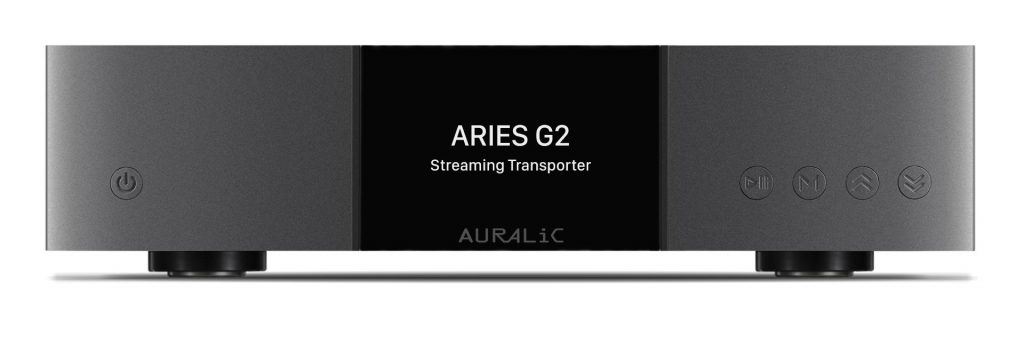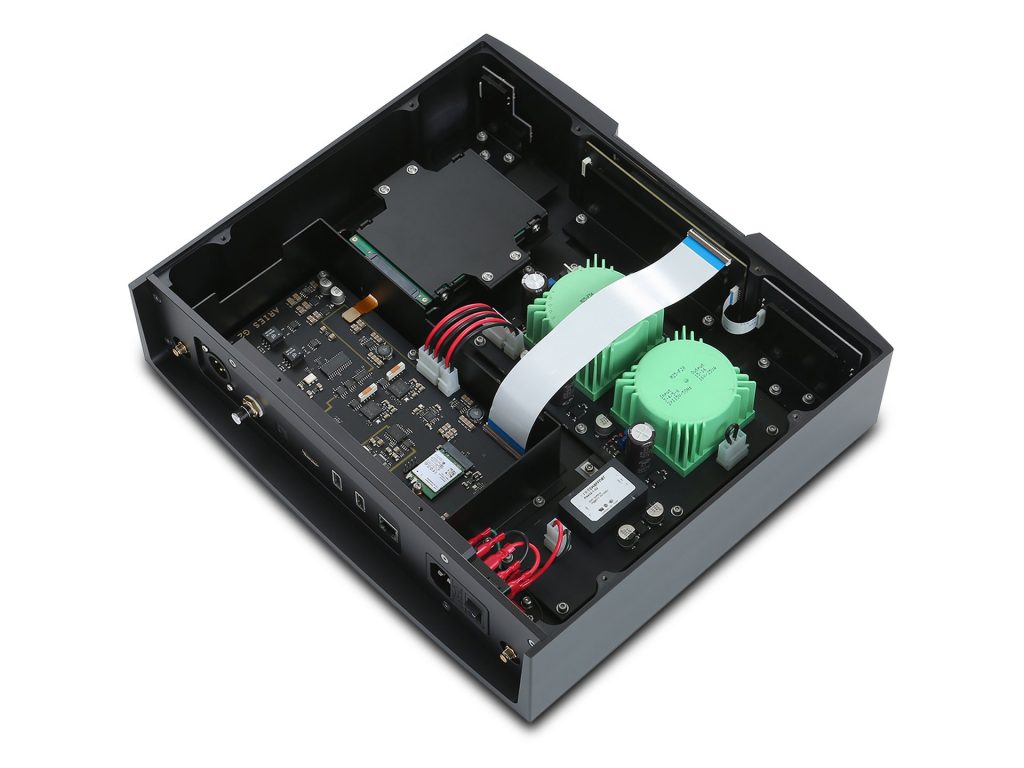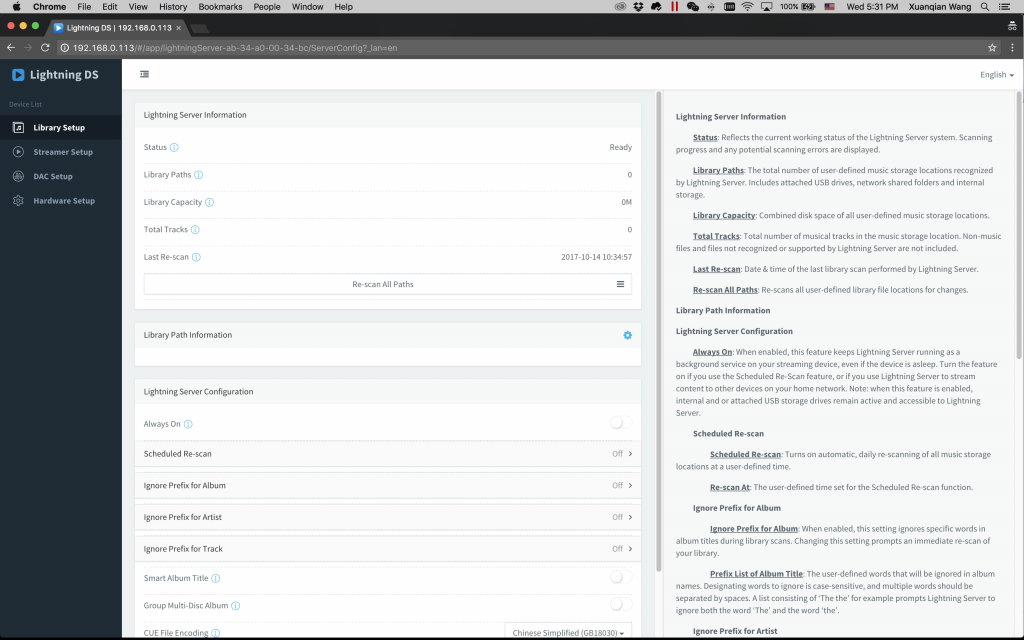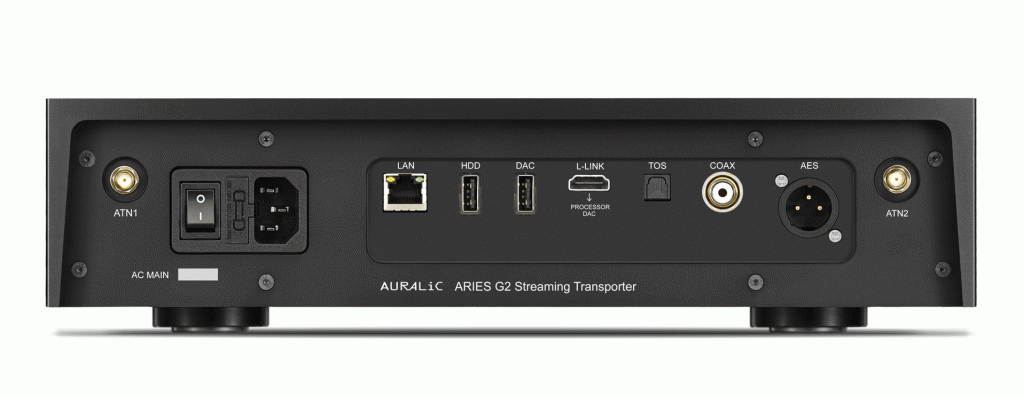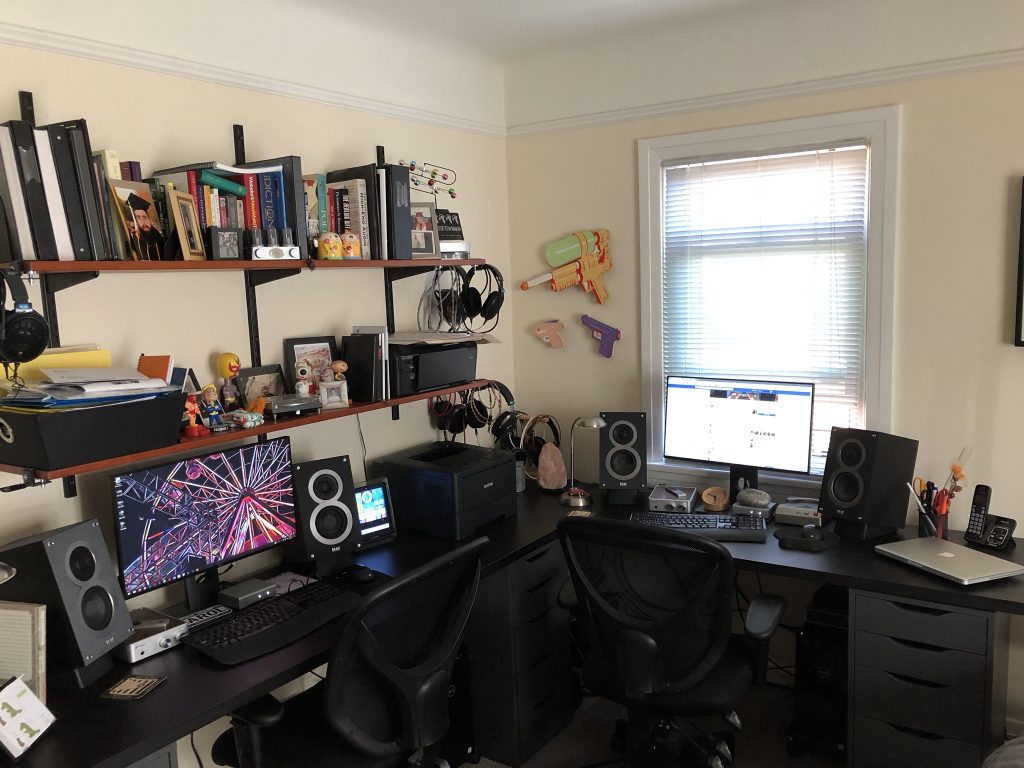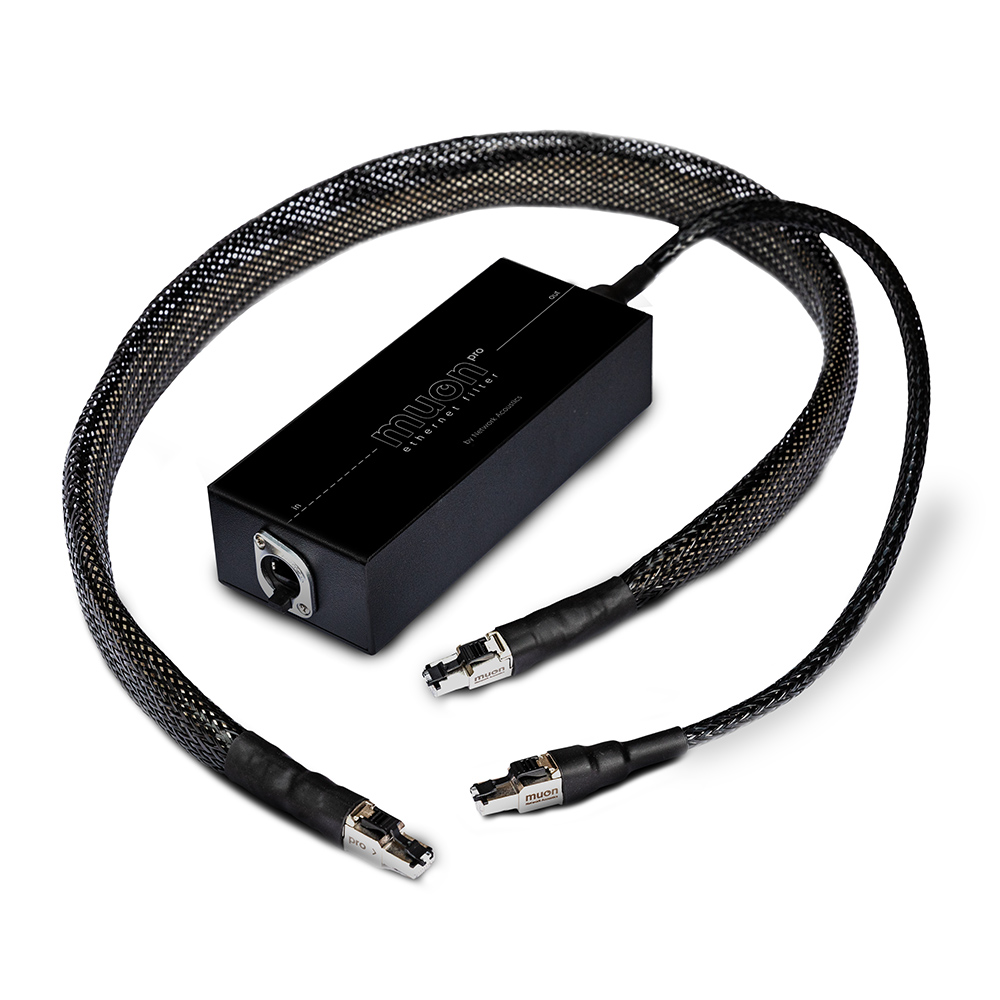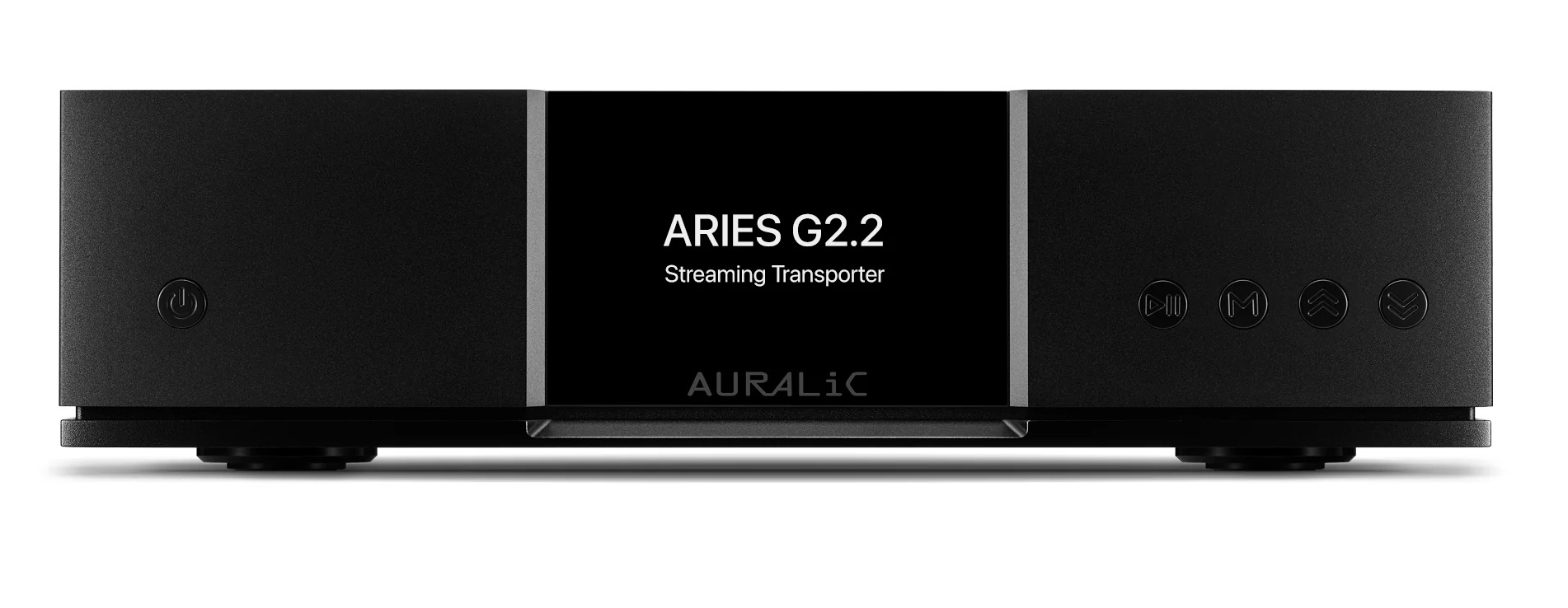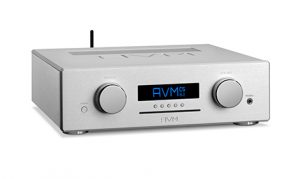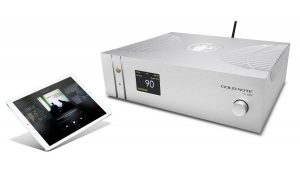I have been a very happy owner and user of the Aries Network Streamer/Renderer from AURALiC for a good number of years (HERE). In its use, the Aries "rendered" our music, make that files, as well as I could ever imagine—pace, resolution, dynamics, extension, clean, articulate, palpable, and so on, and so on, and so on. Simply put: musical engagement. And I loved the interface with their Lightning DS software. With several years of use and nary a hiccup or glitch—for sure there were, but nothing that a refresh, software update, or reboot could not fix—the Aries was replaced with the AURALiC Aries G2 Streaming Transporter ($3899).
Differences? Well the older Aries was one of the cooler units around being cased in a, well case, that was very architecturally appealing—curves and swoops—as well as being made from plastic resulting in the unit having its antennas (when used wirelessly) on the inside as opposed to the outside. This was something Xuanqian really wanted in terms of looks and function—clearly form following function. As someone who is an artist with an eye towards form, I found the older Aries to be a work of visual art. Way cool.
What was not cool was the rear of the older Aries. Due to the swoops and curves, the rear was narrow and cramped, meaning getting one's fingers inside to attach or un-attach any cable was an act of frustration and ingenuity in how to do whatever I needed to do. "Let's see, if I push that with a screw driver, while pulling this with my fingers… there! Got it." "Nope, let's try again."
Along with this, the older Aries was dependent on an external power supply. The basic Aries came with a wall-wart, whereas the upgraded one came with their own external LPS (way better), and if either of those did not float your boat, well this opened the door to experimenting with third party units as well. I ended up with the LPS from SBooster (HERE), finding this match to be simply stellar. Of course, one could then play with a better AC cord and DC umbilical cable (like the one form Sablon Audio). Yeah way cool. And of course, going this route did open a can of worms, or as I like to say, allowed me to run down the rabbit hole of tweaks and so on. Even so, once I reached the bottom, it was the one of the best I had heard in getting my files from the NAS to the DAC.
And using an external LPS meant that if one moved the Aries about a bit too much… disengage. No power… damn it. And it has a remote control that really served little function other than turning the unit on or off as everything else was experienced through the Lightning DS App.
Okay, so here is the Aries G2 with its own internal power supply (see above). One that is extremely well thought out and as good as AURALiC could… oh heck, let me just pull and paraphrase from their site what is new and improved…
- The first of two Purer-Power supplies feed the ARIES G2's processing circuit, LCD display, and storage—whether internal or attached via USB. The second Purer-Power pathway is dedicated to sensitive audio components such as the Femto clock and USB audio output. Both power supplies are galvanically isolated from each other to ensure zero EMI interference between them…
- 1GB of RAM to the task of caching...
- CPU performance that's 50% faster than the original Tesla G1 processor…
- 2 separate Femto, super-accurate clocks cycling on the order of quadrillionths of a second. One clock takes care of digital outputs, and the second regulates USB output…
- GalvanicUSB bypasses the noisy USB power supply… precise re-clocking reduces jitter, and brand-new galvanic isolation provides even more protection against EMI noise…
- The Unity Chassis is machined from a single billet of aluminum that provides the ARIES G2 with superior shielding from EMI noise…
- ARIES G2 internal circuits are physically distributed to enhance overall balance. And with specially designed foot spikes that dampen and absorb vibrations…
And so, a lot of time and thought has gone into how to improve the older Aries—we can make faster, quieter, more powerful, easier to use, and so on. And the end product looks gorgeous while still possessing that feel and presence that sets it aside from other black boxes—looking at the finish work along with the shape, they were able to work in some swoops and curves to really set it apart. Plus, one can still play with AC cords without the need for an external power supply. And it has a way cool LCD screen showing you what is going on. It is easy to set up and control via the web interface on any computer (meaning no remote since between the web interface, the DS app, and the buttons on the front, all will allow you to do whatever you need), and the rear allows for easy access. Downsides… the new unit has external antennas which for me is not big deal but it might be for you, the case finish does pick up fingerprints rather easily, and the feet are designed to address the weight of the unit, so no stacking anything on top of the G2 units. And, one can no longer hot swap USB or digital connections due to how the Aries G2's clock works. Not a big deal… turn the unit off from the front and then from the rear, swap whatever cables one needs to swap, then turn the unit on from the rear… the unit goes through its turn-on cycle as shown on the front LCD, and after 2-3 minutes you are good to go.
All a few minor trade-offs as the new Aries is killer sonically and musically.
Alright, so set up was rather easy, though not quite intuitive. Read the manual and follow it step by step. One can set the Aries G2 up from the front pane buttons rather easily, but my advice is that once it has grabbed an IP address, go through the web interface (as shown above) on any computer or tablet. Way, way easier as it is all there to see on an easy to read screen; which is your screen via whatever browser you happen to choose. Plus, the instructions and explanations of what everything does is right there to the right of the options, meaning they have put the manual there for you to use. Way good. Thanks, AURALiC. Set up and control is now way superior to that of the older Aries—fast, simple, and easy. And stable—no glitches so far, though I do advise anyone to keep up on software and app updates. AURALiC works continually to make the Aries better in any and every way possible for the end user.
Same Lightning DS, so nothing to relearn there, though there are a few updates to how things are sorted and so on, but it looks and works as before—one of the better apps for controlling one's music.
Yeah, but how does it sound over that of the older Aires? Well, given that AURALiC pretty much rethought out the older Aries to make the new G2 series, and in doing so they kept what worked and simply made it better while taking what worked, but needed to be better, (like the power supply, isolation, and so on) and …damn, the Aries G2 is simply stunning.
One of the key things for me is to listen to music at a lower than normal volume—not so much that it is lost in the daily mix but down in terms of being more background to when one has people over to hang and talk to—I do that often. But it will tell you a lot about a component. At lower volumes will you lose the bits and pieces in the music? That is, when one plays any music back at a conversation level I have found that too often ones loses resolution and details… the music is there, but only parts of it. Where did the bass go? What did they just sing? Not so with the Aries G2… turn the volume down and you lose nothing… it is all there. I can still feel the bass; it goes down deep and still has texture and presence. Same in terms of everything else… as I said, you lose nothing. For me this speaks to keeping the noise as low as possible… no crap in the way of the music. It is all there regardless of the volume. Naturally the rest of the system has to be up to snuff as any noise that is added into the mix from A to B to C to D and so on till it hits you smack upside your head will only muck it up. I have gone to extremes here with keeping any noise from getting into the chain—from filters, to cables, to whatever. With the G2, hell yeah! No grain, grit, spit… just music.
Now none of this comes across as edgy, forced, analytically lean and mean. No, just the opposite. With the Aries G2, you get to hear it all with a natural sense of flow and musicality. If the music is warm, it is warm. If it is bright, it is bright. The Aries G2 simply takes your files from wherever they are—and in whatever format or resolution you might have them—and gets them to the DAC as cleanly and with as little editorializing (either by adding or subtracting) as humanly possible.
Okay, so let's turn it up then and see what happens. Well, naturally the sound opens up and things go louder and bigger. The music swells and fills the room. I can play my music louder than before with no fatigue. Once again, clean and articulate. Wonderful presence and flow. Bass to die for and with some track it could kill you. The Aires G2 has a killer bottom end that goes way, way down with such force and control that playing any of our music become a reawakening of these older tracks. I like to hear texture and that palpable presence in the bass… it should not just boom, but boom with a feel—you should be able to feel the bass as one feels texture in an object. Rough, edgy, smooth… and so on. Yeah, the Aries does this better than other units and clearly better than the older Aries. Let's put this on the power supply as the better the power is, the better the control is at the bottom end.
Same with everything else for that matter. Music through the Aries G2 is a real treat. Listening to UNKLE's The Road, Part 1… hell yeah. Low volumes… it is all there. Just as engaging when I turn it up… and up… and up. The music fills the room, the music rocks… one is swept away and totally lost. Slam and dynamics are there in a way that seems just right. Not over the top… not confused or lost in the mire of getting your music out into the room that allows one to hear it all. Ours tends to be dense and filled with stuff… but the Aries G2 keeps it all together while at the same time separating it all in to something that is a beautiful yet cohesive soundscape.
Nice. Now I am going to toss out the word, analog… like. I have always struggles with that term when talking about digital and for sure… yeah, analog-like. Now, I am not saying that the Aries G2 playing files back sounds the same as my analog-rig playing vinyl back (same titles and all)—no, that is comparing apples to oranges. Different formats and different components. But like in the sense that the Aries G2 has a wonderful flow and ease to it, as does spinning vinyl. The music is "warmer" not in the sense of more midrange or whatever, but in the sense of not being cold and sterile—alive as opposed to dead. There is life to the music with the Aries G2 and there is a completeness. I think that is what I mean by flow, or as Art Dudley would say, continues-ness. Or something like that. Getting old. Me that is, but music with the Aries G2 is not. No, with the Aries G2 it is all new and wonderful. Perhaps seamless is the best option in suggesting the Aries G2 is analog-like. Like I hear with vinyl. For sure, a digital signal is not as complete as an analog signal; missing pieces and all, but with the Aries G2 one is hard put to hear what is not there.
I am using the Aries G2 wired with various Ethernet cables—Wireworld Starlight Cat 8, Cardas Clear, or Sablon Audio's. All works as noted elsewhere in writings for PF. It does work as advertised when used via WiFi with any differences being rather negligible. My files are primarily 16/44.1 with a smattering of 20/44.1. 24/96. Or 24/192. No what I am saying here is based on that. Oh, if it matters… the files are an assortment of .wav, .flac, .aiff, and .aflac file formats. No glitches. The music plays.
Name your connection - the G2 is easy to access and allows for anything and everything.
Now I have no idea what my music should sound like… I have no idea how it should sound. I have said this time and time again in other reviews, but I do like how it sounds with the Aries G2… more than any other unit I have had here. As it stands, the Aries G2 is getting our music out into the room in a way that far surpasses what the older Aries did and in a way that for anyone who has sat here and listened… is way fun. Engagingly fun and not in a way that is audiophiley clichéd—no our system does not present the music with a sound that could be described as being proverbially audiophile—hyped and artificially musical. My Highest Recommendation and for me, clearly a reference.
An addendum of sorts… Not sure if any streamer/renderer should have a sound. That is should the Aries G2 sound like something? I do believe that the software will impart a sound and for sure the ability to process, address noise, providing clean and robust power… all of this and more can impact the sound. Meaning you might not be hearing all that is in the file, or your music, as is possible. All my comments are based with the Aries G2 and its supplied AC cord. I did swap in an American Digital cord from Triode Wire Labs—uh… wow, nice addition. Take what I have said here and move that up a bit further. More and more of everything. I will say that the American Digital AC cord is light and really did not appear to weigh down the Aries G2. The manual suggests not to use a heavy audiophile AC cord as doing so will impact the unit's feet in isolating the Aries G2 from whatever. They are designed for the Aries G2's weight, and so adding anything that increases the weight will mitigate their performance. Works fine and sounds way good with this cord, though that is a matter of preference.
Specifications
- Streaming File Formats: (Lossless) AIFF, ALAC, APE, DIFF, DSF, FLAC, OGG, WAV and WV. (Lossy) AAC, MP3, MQA, and WMA
- Sampling Rates: (PCM) 44.1KHz to 384KHz in 32Bit. (DSD) DSD64 (2.8224MHz), DSD128 (5.6448MHz), DSD256 (11.2896MHz), DSD512 (22.57892MHz)
- Control Software: AURALiC Lightning DS for iOS, AURALiC Lightning DS for web browser (device settings only), OpenHome compatible control software (BubbleUPnP, Kazoo), Roon (Roon Core required separately)
- Streaming Inputs: Network shared folder, USB Drive, Internal Music Storage, UPnP/DLNA Media Server, native TIDAL and Qobuz Sublime+ streaming, Internet Radio, AirPlay, Bluetooth, Songcast, RoonReady
- Audio Outputs: AURALiC Lightning Link
- Digital Outputs: AES/EBU, Coaxial, Toslink, USB
- Network: (Wired) Gigabit Ethernet. (Wireless) 802.11b/g/n/ac Tri-Band WiFi
- Power Consumption: (Sleep) <10W. (Playback) 50W at max.
- Dimensions: (W x D x H) 13.4 x 12.6 x 3.2 in. (34cm x 32cm x 8cm)
- Weight: 15.9 lbs (7.2kg)
- Product Finishing: Anodized precision-machined extrusion aluminum case in matte black
AURALiC
All images courtesy of AURALiC




